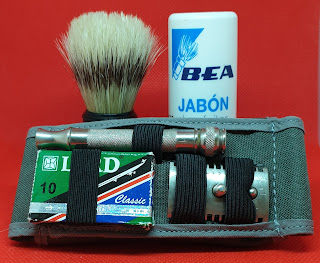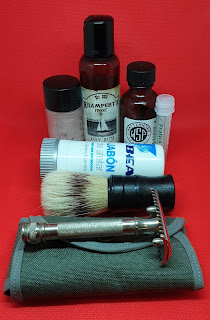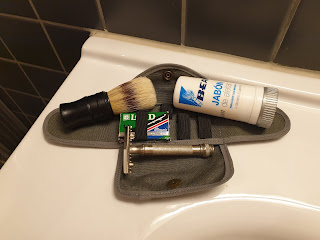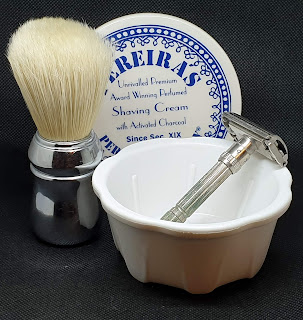Razor: Gillette Old Type “Khaki”
Blade: Lord Classic
Brush: Omega #50014 Travel
Lather: BEA Shavestick
Aftershave: Krampert’s Finest Bay Rum
Additional Care: Alum Travel Stick, & WSP Matterhorn Beard Oil
Tag Archives: Gillette
Shave of the day 4th September
What goes in the GoBag?
When I talk about my GoBag, I talk about the bag I grab whenever I have to go somewhere for my job – for training, classes or other happenings that usually means long days and little sleep. But no sleep for several days in a row don’t mean that you have to end up as a shambling, unkempt zombie… on the contrary; with the right gear in the GoBag and a fifteen minute break you can be a neat and dapper walking dead (lets face it; shaving does not replace sleep).
- Alum stick in a travel container
- A travel sized thing of Krampert’s Finest Bay Rum aftershave
- A bottle of WSP Matterhorn beard oil
- A small styptic pencil, just in case
- A BEA shavestick
- An Omega #50014 travel brush
- A “Khaki Kit” with a vintage Gillette Old and a pack of blades
I haven’t had to use the styptic pencil yet, and I’ve just switched from my vintage one hundred and one year old original khaki kit to a modern recreation I received recently.
Shave of the day 2nd September
Shave of the day 30th August
…like climbing ten flights of stairs
If you are still depending upon the barber or old fashioned razor you are in the same category with the man who climbs ten flight of stairs when there is an elevator in the building.
While there is many things we can gleam from this advertisement from May 1908 – one of which is the almost curious lack of contractions (“you are” instead of “you’re” in the small excerpt I copied above) – the two that stands out to me is the fact that a safety razor with a dozen blades set you back a mere 5 USD, and you could get combination sets for tens times that price.
Adjusting for a hundred and eleven years of inflation, that equals about 140 USD for a single razor with blades, and a whooping 1400 USD for the most expensive set…
More razor infrastructure – the art of the sale
So you invented a safety razor. You designed the machinery for making blades cheaply and easily. But until you can convince shavers to buy your razor, you’re nowhere close to turning every man into his own barber.
Selling is – I’m told – mainly about presentation, double so when selling to a merchant. And who wants to rummage around in a dark box to pick up a cased razor? So Gillette bought out a patent by Mr Nelson H Fairweather for a suitable display case; one I think would be well suited to a travelling salesman peddling his wares to merchants.
The mechanism is simple, yet elegant… as the lid opens, the tray with the wares lifts up and locks in place – a neat little trick, just the thing to lend a little extra to your sales pitch.
An early patent for adjustable razors
Thanks to Glenn’s website covering the history of Gillette’s adjustable razors, I found a very important number… the number is one million, five hundred and ninety nine thousand, seven hundred and ninety three. As in US patent number 1 599 793, that is.
To quote from the patent description, it
…relates particularly to an index’adjusting device for use in connection with safety razors of the Gillette type wherein a flexible and elastic blade is provided with cutting edges that are adjustable toward and from the guard member of the razor
In short, it’s about how to make an adjustable razor adjustable.
As can be seen from the image, everything interesting is happening in the head or right below it. Adjusting the dial 16 makes the top cap move up and down in relation to the base plate, while the base plate stays fixed in relationship to the handle. In order to remove or insert a blade, the shaver would turn the dial around and around to unscrew the cap. In other words, this very early version of the Gillette Adjustable works much the same way a Merkur Progress does – although without the central bar the Progress have.
I don’t think Gillette ever manufactured – apart from prototypes – this razor, although it must be pointed out that the method of adjusting this razor bears a lot of resemblance to how Gillette suggested one could “adjust” an Old type razor back when it was first offered:
If a close shave is desired, turn the end of the handle back a little and the edges of the blade will lift slightly from the guard thus permitting closer contact with the face. A moments practice will show the proper adjustment.
The patent is expired, and thus anyone can make a razor like this today; however bear in mind that other aspects of a good adjustable may still be covered by patents. It would still be interesting if a machinist decided to have a go though, so we could compare how far this version is from the other adjustable safety razors.
/Update: I originally believed this was an early Gillette patent, but discussion and research by the members of the Shave Nook showed that this patent was never assigned to Gillette.
Types of safety razors; a pictorial guide
Lets face it; safety razors can be confusing for those new to traditional shaving, and to old hands too. Some of us can instantly imagine what a three piece open comb double edge razor would look like, but others might feel a bit more lost in the jargon. So lets walk through part of my razor rotation and collection and highlight at least some of the common terms.
 |
| Gillette Slim w/ solid bars vs Gillette Old w/ open comb vs Asylum Shaveworks RX with scalloped bars |
 |
| Phillips Philite razor with a scalloped plate vs Yaqi Mini with toothed base and top cap |
While it’s tempting to claim you can either have a safety bar or an open comb (OC) – like the original Gillette Old Type – but in reality there are a number of razors straddling the line with scallops. My Phillips Philite is a good example of one that do just that, with it’s deep scallops that let lather run through the head of the razor. Some OC razors continue the comb on the top cap, but to my mind this has more to do with aesthetics and not with function.
 |
| Merkur 985CL three piece vs Gillette Old Type two piece vs Gillette TV Special Superspeed one piece |
 |
| Merkur 39C slant and the Merkur (most likely) Bakelite slant |
 |
| Gillette Slim adjustable vs Gillette TV Special Superspeed non-adjustable |
Some razors lets the shaver adjust the aggressiveness on the fly, while others have a fixed blade gap and angle set once and for all. While the added utility can be nice to have, it do make the razor mechanically more complex and drives the cost up in addition to making the head thicker to contain the mechanism. A few modern three piece razors offers several base plates so the shaver can adjust the shave without the added complexity, but those cannot be adjusted on the fly like a traditional adjustable can.
 |
| GEM Micromatic Clug Pruf single edge vs Mergress Adjustable double edge |
 |
| Asylum Shaveworks RX in stainless steel vs GEM 1912 in brass vs Parker 22R partly in zamak vs YUMA in potmetal vs Philips Philite in a bakelite analog vs an unnamed medical razor in plastic |
Safety razor can be made from almost any material, from titanium down to wood… and to some extent the choice of material affects the feel of the shave and the hole left in your wallet after buying one. High end razors these days are often made from hard, durable materials such as stainless steel and titanium, while zamak has gotten an undeserved bad reputation in my opinion. And while I do try to limit my consumption of plastic thee days, there is nothing inherently wrong with plastic as a material for an inexpensive safety razor; it does what it needs to do and is affordable,
The wood razor I referred to? That was the Welch’s Saratoga, also known as the E-KON-I-ME and was a pre-plastic disposable.
Hopefully that was informative and helps clear things up for those who were unsure of the terminology.. if I missed out on something, please let me know.
Shave of the day 26th June
Razor: Gillette Slim
Blade: PolSilver Super Iridium
Brush: Omega #10048
Pre-Shave: The Lavish Gentleman Natural Strength Oil Cleanser
Lather: Pereira Shavery Shaving Cream w/ Activated Charcoal
Aftershave: BullDog Sensitive Aftershave Balm
Additional Care: Alum Block, Gentlemen of Sweden Original Beard Oil, & Pereira Shavery Boomerang Beard Comb








